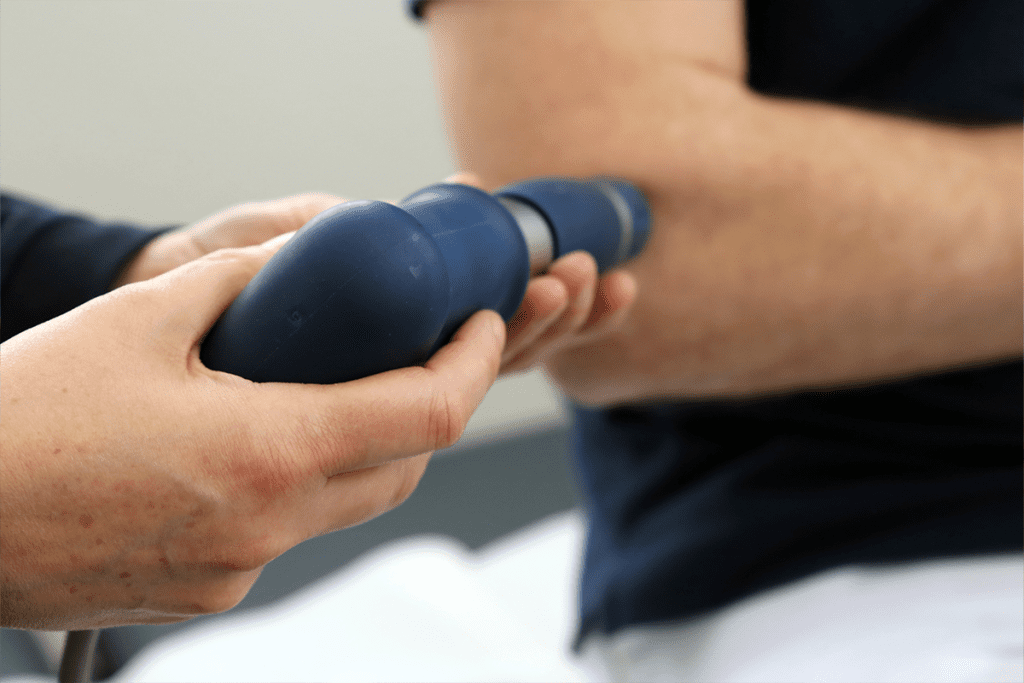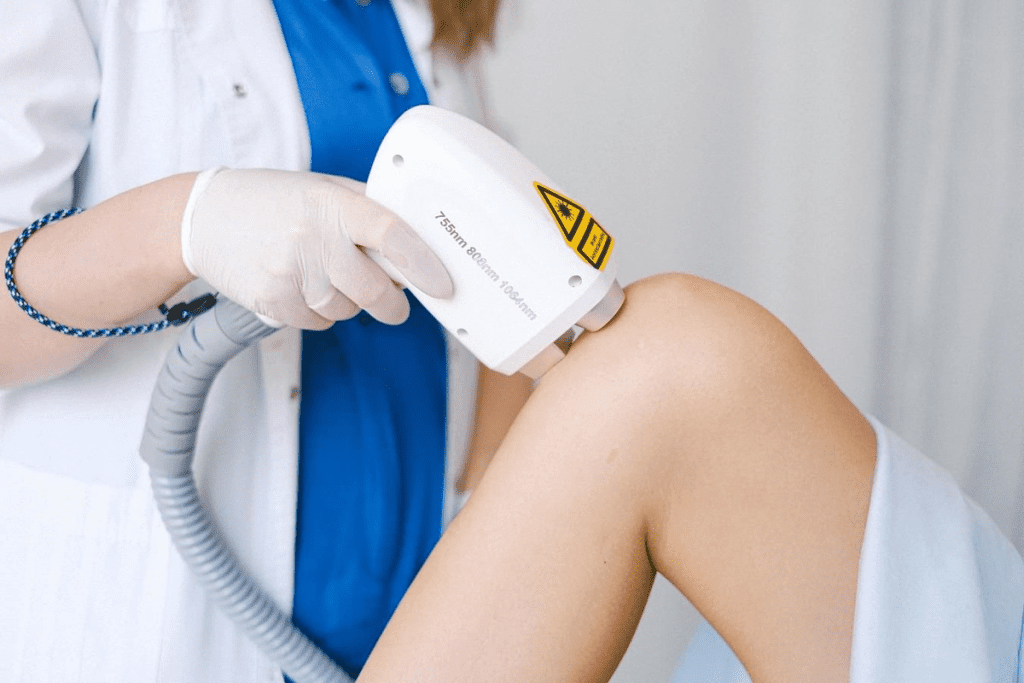Last Updated on November 25, 2025 by
At Liv Hospital, we focus on safety and quality. Shockwave therapy, also known as extracorporeal shockwave therapy (ESWT), is a non-invasive treatment. It’s popular for treating musculoskeletal conditions.

We treat chronic tendonitis, plantar fasciitis, and Achilles tendonitis with ESWT. While it’s safe, knowing the side effects is important. This helps patients make better care choices.
ESWT was first used for kidney stones. Now, it’s used in orthopedics and physical therapy. It’s a non-invasive way to heal and reduce pain in many musculoskeletal issues.
ESWT uses high-energy shockwaves to help the body heal. Originally for kidney stones, it now treats many conditions. It boosts blood flow and helps fix damaged tissues.
There are two types: focused and radial pressure waves. Focused shockwave therapy targets specific areas, great for tendonitis. Radial pressure waves treat larger areas, like plantar fasciitis.

Shockwave therapy helps with many issues, including:
A study of 632 patients showed little discomfort and no serious side effects. This proves ESWT is safe and effective for many conditions.
Our hospital uses the latest medical tech to help our patients. Understanding ESWT helps us see its benefits and possible side effects.
Shockwave therapy is mostly safe, but some side effects can happen.We, at Liv Hospital make sure our patients know what to expect. This includes what happens during and after treatment.
Extracorporeal shockwave therapy (ESWT) can cause temporary pain or discomfort. This pain is usually mild and goes away quickly after treatment. We use the latest technology to make sure you’re comfortable during the process.
Some people might feel pain because the shockwaves go deep into the tissue. But this pain is short-lived and can be eased with simple pain relief.
Skin and tissue reactions are common side effects of shockwave treatment. These can include redness, swelling, numbness, bruising, and increased sensitivity. These effects are usually mild and go away in a few days.

We keep a close eye on our patients to reduce any bad effects and help them recover smoothly. Sometimes, patients might see a mild hematoma or swelling. But these can be managed with the right care after treatment.
The time it takes for side effects of ESWT shockwave therapy to go away varies. But usually, they last only a few days to a week after treatment.
We tell our patients to follow our post-treatment instructions carefully. This helps avoid complications and speeds up recovery. Most people can go back to their usual activities soon after, with some minor adjustments to handle any temporary discomfort.
Shockwave therapy is usually safe, but there are rare serious side effects. At Liv Hospital, we make sure our patients know about these risks. This way, they can make informed decisions.
Shockwave therapy, or ESWT, is used for many medical issues. But, like any treatment, it comes with risks. Rare but serious side effects include tendon rupture, bone injury, and other uncommon reactions.
Tendon rupture is a rare but serious side effect. It happens when the tendon gets too much stress during treatment. People with tendon damage or on certain meds are at higher risk.
Other tissue problems can be bruising or hematoma at the treatment site. These are usually temporary but can be painful and need extra care.
Bone-related side effects are rare but serious. Bone fractures or osteonecrosis (death of bone tissue) have happened in some cases. These are more common in people with osteoporosis or other bone issues.
It’s important for patients to share their full medical history before getting shockwave therapy. This helps lower these risks.
Other rare side effects include nerve damage, leading to numbness or tingling. Skin reactions like redness or irritation at the treatment site can also happen. In rare cases, an allergic reaction to the gel used during the procedure can occur.
At Liv Hospital, we focus on personalized care. We consider each patient’s health and history to reduce risks. If you’re thinking about shockwave therapy, talk to your doctor about your specific risks and benefits.
Many studies have looked into shockwave therapy’s safety and how well it works. Our personnel keeps up with the latest research. This ensures our patients get the safest and most effective treatments.
We are dedicated to ongoing education and research. This commitment helps us offer top-notch healthcare. We also provide international patient support and guidance.
Many meta-analyses and clinical studies have shown that shockwave therapy is safe. Most patients find it well-tolerated, with few side effects. A detailed review of trials found that adverse effects are rare and usually mild.
“The safety and effectiveness of ESWT have been extensively validated through rigorous clinical studies,” showing it’s a good treatment for many musculoskeletal issues. We keep an eye on new research to keep our treatments up-to-date.
While shockwave therapy is generally safe, some patients need extra care. For example, those with bleeding disorders or on anticoagulants might face a higher risk of bleeding. Pregnant women, children, and adolescents also need special consideration.
It’s important to keep researching shockwave therapy’s long-term effects. We should also watch patients closely who are getting this treatment. Encouraging them to join clinical studies helps us learn more about their safety and effectiveness.
“As our understanding of shockwave therapy evolves, so too will our ability to tailor treatments to individual patient needs, maximizing benefits while minimizing risks.”
Shockwave therapy, also known as extracorporeal shockwave therapy (ESWT), is a valuable treatment for many medical conditions. At Liv Hospital, we focus on quality and patient experience. We aim for high ethical standards, innovative healthcare, and a superior patient experience.
While ESWT is generally safe, it’s important to weigh its benefits against possible side effects. These can include pain or discomfort during shock wave therapy and rare but serious complications. Knowing the risks and benefits helps patients make informed choices about their treatment.
We make sure patients get the best results from their shockwave treatment. We aim to provide exceptional healthcare experiences. This combines medical expertise with empathy and understanding, making therapeutic shock a viable option for those seeking advanced medical treatments.
Shockwave therapy, also known as extracorporeal shockwave therapy (ESWT), is a non-invasive treatment. It uses high-energy sound waves to help heal and reduce inflammation in muscles and bones.
Common side effects include temporary pain and discomfort. You might also see redness, swelling, or bruising on your skin. These usually go away within a few days.
Yes, though rare, serious side effects can happen. These include tendon and tissue problems and bone-related issues. But these risks are low if the treatment is done right.
Side effects usually last a few days to a week. This is after you’ve had the treatment.
Shockwave therapy is generally safe. But some people with bleeding disorders or pacemakers need extra care. Our team at Liv Hospital checks if it’s right for you.
Focused shockwave therapy is more precise and targets a specific area. Radial pressure waves cover a wider area. They both use ESWT, but in different ways.
Studies show that shockwave therapy works well for many muscle and bone issues. This includes plantar fasciitis, tendinitis, and calcific shoulder tendinitis.
You might feel some discomfort during treatment. Afterward, you might see redness or swelling. These are usually mild and short-lived.
Yes, research is ongoing to keep shockwave therapy safe and effective.
Subscribe to our e-newsletter to stay informed about the latest innovations in the world of health and exclusive offers!